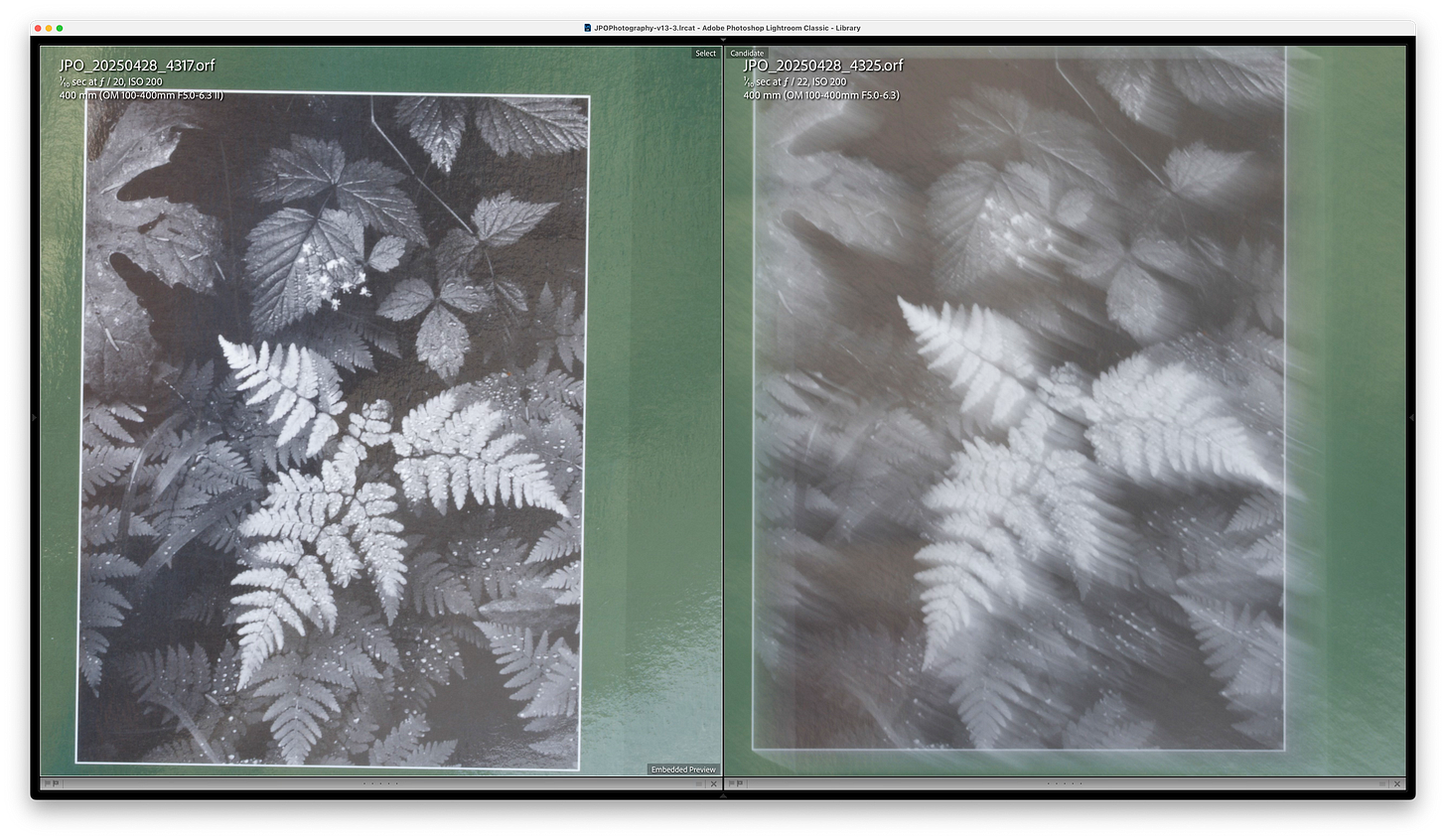OM System 100-400mm f/5-6.3 Mk II Hands-On Review
The new version adds improved image stabilization and weather sealing, but is it worth the upgrade?
A couple of weeks ago, I got my hands on a production copy of the recently updated OM SYSTEM M.Zuiko Digital ED 100-400mm f/5-6.3 IS II lens (if that’s a mouthful, check out my article, Lens Alphabet Soup). I purchased the original version of this lens in 2023, and found it to be an excellent option for wildlife and other subjects. The 100-400mm lens offers a 35mm equivalent of a 200-800mm lens in an extremely compact design. It weighs just under 3lbs (1.3 kg), which makes it extremely easy to hand-hold.
What I found with the original lens was that its built-in stabilization system (IS) was actually quite weak (it’s an older design). However, by switching the IS off on the lens barrel and using the IBIS in the OM-1 camera, the lens was reasonably well-stabilized. At the longest focal length settings, there was modest but manageable viewfinder shake. While the 100-400mm lens is compatible with both OM System teleconverters, I found using them to be particularly difficult, despite the optical quality being quite good.
When OM System announced an update to their 100-400mm lens, I was pleased to see that it included a much better IS system: Sync IS. This allows the camera to use the IS in the lens and synchronize it with the built-in IBIS system, and boosts the stabilization to up to 7 stops. The new lens also has enhanced weather-sealing; it is splash rated at IPX1 and also dust resistant. Optically, however, it remains the same design as the original version of the lens.
Design and handling
The OM System 100-400mm f/5.0-6.3 IS II has an optical design identical to its predecessor. The lens has 21 elements in 15 groups, and the aperture varies from f/5 at 100mm to f/6.3 at 400mm. The lens accepts 72mm front filters and has a 7-bladed aperture. The lens includes a removable tripod collar and the foot is natively Arca-Swiss compatible, which will save you some money on accessories should you wish to use it on an Arca-Swiss clamp tripod or monopod mount.
Cosmetically, there’s virtually no difference between the Mk II and original lenses. Both have three switches on the left side of the barrel:
Focus limit
AF/MF
IS On/Off
On the right side of the lens you’ll find a zoom lock switch, which prevents the lens from extending when engaged. The large zoom ring is to the rear of the focus ring, which is the configuration I generally prefer. The zoom itself is an external design, meaning that the lens barrel extends outward when you turn the zoom ring. The zoom action is smooth, but slightly stiff when compared to internal zoom designs.
Performance
Subjectively, I couldn’t see any differences in optical quality between the two lenses. They are both quite good, but certainly not as clean and sharp as my OM System 150-400mm f/4.5 TC lens. Out of focus highlights sometimes are rendered with mild “donut” bokeh, but it’s not that big of a deal for a lens at this price point. Focusing is relatively fast, and it’s very easy to hand-hold on my OM-1 Mark II body, especially with the optional vertical grip. Looking around my neighborhood for backyard birds, I came across this American Robin and the lens delivered a nice sharp series of shots.
Next, here’s a look at how out of focus highlights are rendered. You can see the “donut” bokeh I was describing earlier. It really only shows up with speculars, like reflections on water, or in this case, grass. I saw the exact same effect with the original version of the lens, so no change there.

Using teleconverters
I had only tried using the 1.4x MC-14 teleconverter once before with the original version of the 100-400mm, and I quickly concluded I wouldn’t be using it. The problems were two-fold: focus accuracy and stabilization. Above 300mm native focal length, I found that the IBIS of the OM-1 and OM-1ii simply are pushed beyond their useful limit. The EVF image becomes extremely jittery and maintaining composition is very difficult. The focus accuracy seems reduced, too; that’s probably due to the extremely large effective depth of field when using a TC. With the MC-14 (1.4x) TC, you get the equivalent of a 1120mm f/9 lens, and I saw occasional back-focus. I think it was simply an issue of the camera not being able to tell that the subject wasn’t quite focused precisely even though it was slightly off.
With the new MkII version of the lens, using the 1.4x teleconverter is far more useable. However, I didn’t get nearly the keeper rate as I would have with the lens alone. But when the focus was on-target, the shots were sharp:

Stabilization Performance
A good image stabilization system offers photographers two significant advantages. The first is the ability to get sharp images even at what would be considered “slow” shutter speeds. Consider the old rule of thumb that you should set the shutter speed to 1/effective focal length. In the case of the 100-400mm lens and a 4/3 sensor, that would imply 1/800s or faster at the longest focal length. A good stabilization system should let you shoot slower than that and still get sharp shots, provided the subject isn’t moving much. Here’s a series of comparison shots between the new (MkII) lens and its predecessor. In each pair of photos, the MkII image is on the left side. These were all shot hand-held, and I’ve zoomed the screen to 1:1 view.


The other big advantage of a well-stabilized lens is the viewfinder image itself. With the best stabilization systems, it’s far easier to maintain your composure in the viewfinder and get the shot you want. This is particularly true with very long focal lengths, as you’ll get when using a teleconverter. In this test, the MkII version of the 100-400mm is significantly better, and to show you, I’ve produced a short video using captures from the camera EVF itself.
I think it’s pretty clear from those clips that the IS system in the MkII lens is superior to that of the original version. Pro tip: If you’re using the original 100-400mm, set the IS switch on the lens barrel to OFF, and enable IS in the camera via the menus or Super Control Panel.
Conclusions
The original OM System/ Olympus 100-400mm f/5-6.3 IS lens is a good optical performer, gets you out to 800mm equivalent, and is incredibly compact for a lens with this much reach. The new MkII version improves on this design by adding significantly better image stabilization (IS), which should be evident in my test shots. While both versions of this lens are compatible with OM System teleconverters, only the MkII version makes using them practical, as long as you’re aware of the limitations. Even with a TC, the lens delivers sharp results as long as the focus is accurate.
Should you buy/upgrade to the 100-400mm IS II?
At a list price of $1500 US, the 100-400mm f/5-6.3 IS II lens isn’t inexpensive, but it’s definitely the least expensive super-tele zoom in the OM System lineup. The other two lenses, the 150-600mm and 150-400mm TC, cost $2700 and $7500, respectively (although you can sometimes get an instant rebate on the 150-600mm lens).
In my opinion, if you want a longer lens to photograph birds and wildlife and don’t already own the original 100-400mm lens, I’d definitely get the newer version. It’s improved IS system is markedly better, and the weather sealing means you can use it in the rain without a rain cover. If you already own the original 100-400mm lens, the decision becomes more complicated. Optically, the original lens is just as good as the new model. It’s the stabilization system that’s the weak point. If you don’t need to use a teleconverter and keep your shutter speed relatively high, it’s perfectly good. Moreover, you can generally get a good deal on the original model on the used market; they’re around $850.
The real advantage of the 100-400mm MkII is the improved IS system, which now offers Sync-IS on OM-1 bodies. With the new version of the 100-400mm lens, you can easily get sharp shots hand-held down to 1/100s (or slower) and using OM System teleconverters becomes a real option if you want even more reach. The other two OM System super-telephoto zooms are not only much more expensive than the 100-400mm, but also heavier and larger. The OM System 100-400mm f/5-6.3 II is a fantastic option for a low(er) priced telephoto lens that gets you to 800mm equivalent and fits in small camera bags. Overall, I highly recommend it to micro 4/3s shooters.
Full Disclosure: I received a production copy of this lens on loan from B&H Photo. I have not received any compensation for writing a review.









Perfect timing, as I just got my lens. This helps! Thanks
Thank you Jason. Were you able to compare the image quality to that of the m.zuiko 300mm f4?